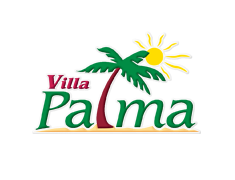
Čiovo island and beaches
Villa Palma*** Hotel - Restaurant: Okrug Gornji - Ciovo
OKRUG GORNJI
Okrug Gornji is a village in the west of the Isle of Ciovo, right at the Bay of Movarstica. Okrug Gronji has a mild and benign climate and lush Mediterranean vegetation. The region is abundant with small, clandestine bays.
Above the Bay of Movarstica are the ruins of the church “Sveti Mavar”.
There are a number of restaurants, pubs, wine bars and amusements on the seafront. Water ski rental, scuba diving school and a fitness centre with tennis courts are located at only 2 miles from Trogir.
CIOVO
Ciovo is a small island just off the Adriatic coast of Croatia in the Bay of Kastel, close to the town of Trogir.
Area: 11.2 square miles
Length: 9.5 miles
Breadth: 2.2 miles
Population: 4.455 (2001)
Population density: 409 persons/square mile
Highest peek: Rudine (722 ft)
The Isle of Ciovo lies just off the mainland town of Trogir, which used to be an important port as early as in the Roman era. Ciovo and Trogir are connected by a bridge. The eastmost tip of the isle is very close to the Split Peninsula. South of Ciovo is the Isle of Solta.
The Isle of Ciovo, now virtually grown together with Trogir, is a top holiday spot for everyone wishing to enjoy their holidays in perfect tranquillity.
In the south-east the isle is only 1.25 miles away from Cape Marjan (Split), whereas in the north it is connected to the historic city centre of Trogir by a bridge (part of Trogir, due to its growth in size, is now equally located on the isle). Ciovo, inhabited since prehistoric times, boasts a rich cultural heritage. Its pristine beaches and turquoise sea are simply irresistible.
When the Mongols descended upon and ransacked Hungary in the 13th century and King Béla IV had to flee the country he spent some time on Ciovo. Its beaches belong to what is known as the Trogir-Seget-Ciovo Riviera. Ciovo covers an area of about 11.2 square miles. The highest elevation on the isle is Mount Rudine (722 ft). Along the northern coast the landscape is gently sloping, whereas it is steeper and more rugged in the south. The shipyard of Trogir, first established in 1888, is also located on the Isle of Ciovo.
Holidaymakers seeking pure water fun or just a quite spot to bask in the sun to relax will find many terrific bays. The most popular ones are Uvala, Duga, Tatinja and Movarstica in the south and Arbanija and Slatine in the north. A wide range of leisure and sports activities are available to choose from – no matter whether you prefer going into, onto or under the water.
Shaped like a lake, the picturesque Bay of Saldun in the east of the isle. The coast is largely built-up with houses, mansions and cottages, whereas such built-up areas are interspersed with beaches (right above the bay, adjacent to Cape Cubrijan is the village of Ciovo and Okrug Gornji is not far away either).
Crews of larger yachts will find conditions ideal as they can anchor their vessels in safety in the bay below Cape Cubrijan. Smaller yachts are advised to drop anchor in the south-eastern Bay of Fumija, which is entirely sheltered due to three surrounding islands. The port of Trogir, ACI Marina Trogir, is another important yacht harbour. It is located on the Isle of Ciovo, opposite the historic city centre. Well sheltered from the winds, the harbour is open all year round. It has 180 pontoon berths and another 18 dry berths ashore with facilities such as power and water connection points at each berth. A repair facility, a 10 ton crane and a refuelling station complete the range of services. It goes without saying that amenities such as bathrooms, showers, a grocery store and restaurants are also available to the crews. The marina is set against the majestic backdrop of the historic city centre of Trogir, a UNESCO world cultural heritage site.
Opposite the mainland town of Trogir lies the village of Ciovo, now covering the entire Saldun peninsula. It is a very popular tourist destination. Although the village does not look quite as old as the downtown area of Trogir, the atmosphere is distinctively Mediterranean: take a stroll in the narrow streets between small houses. Other sights include the Franciscan and Dominican monasteries as well as the petite “St. Marvo” church. If you are keen on a boat trip you may consider visiting the small isles of Kraljevac and Sveti Fumija to the south of Ciovo. Sports enthusiasts will find a whole lot of activities to choose from. The vegetation is Mediterranean with palm trees, olive trees, vineyards and lemon trees.
Other villages on the isle include:
• Arbanija
• Okrug Gornji
• Okrug Donji
• Slatine
• Prizidnica
• Zedno
Beaches
The resort is renowned for its child friendly sand beaches.
With the sea being shallow and not getting deep abruptly, you can relax while your young ones play and splash in safety.
The bay is sheltered from the winds and thus from waves.
The shallow water makes a number of pristine and clandestine bays and sand beaches ideal for families with small children.
There are easily accessible fine shingle and rocky beaches as well.
The most popular beaches include
Pantan beach – this 550-yard-long fine shingle/sand beach bordered by a pine forest in the east is only one mile away from the city centre of Trogir.
Okrug beach – the most popular beach of the Trogir-Seget-Ciovo Riviera, at a distance of about 3 miles from the city centre. The 1.3-mile-long beach is alive with people in the evening.
Kava beach (Slatine) – this beach is located in the east of Ciovo, about 7.5 miles from the historic city centre.
Medena beach (in Seget) – a 1.9-mile-long shingle beach surrounded by a pine forest with a great many water sport activities on offer.
